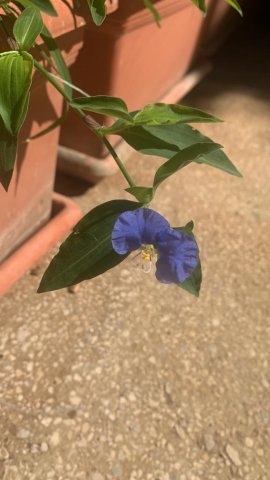A couple of weeks ago, while un-weeding my planters in the morning, I discovered this beautiful blue flower that seems to have grown out of nowhere! I didn't know what it was and made a mental note to take a picture of it to research its name. I was surprised to find out there was no flower when I came back that evening after work. I was sure I had seen it. Where had it gone? Did Loki, my cat, nibble on it? The next morning, while watering the planters next to where I had seen it, there was another blue flower! I then understood that this bloom didn't have a long time span, and it made the search for its name easier.
So, without further ado, meet Commelina Communis, sometimes called the Asiatic dayflower, the Widow's flower, or simply the blue dayflower. It flowers from July to September, so I think I was lucky to experience it by mid-September. The bloom lasts only a day and will have deflated come evening. The species has its origins in Japan and East Asia, where it is also used as a medicinal herb. It requires fertile, sandy, or rocky, well-drained soils to grow. It is resistant to pests and propagates by seed or division. And so now I know, one of the birdies visiting my garden must have brought it. What a beautiful gift!
The leaves of Commelina Communis are depurative and diuretic. As a throat gargle, it can relieve sore throats and tonsilitis. Extracts of the plant show anti-bacterial properties. The different species growing in different regions show different characteristics. It is used to treat respiratory issues, inflammation, urinary infections, nosebleed, hypertension, hemorrhoids, or even for livestock. The seeds can be ground and mixed with millet in India. Some populations use Commelina Communis in their foods as well.
I will end this post with an Irish blessing: May flowers always line your path and sunshine light your day!
Happy gardening🌱

